The Two Labrador Retrievers

American-bred Labs and British imports offer differing merits to today’s waterfowler
By Brian Lovett
Duck hunters love lively debates, whether the topic is divers versus puddlers or pumps versus semi-autos. In recent years, many campfire discussions have focused on retrievers — specifically the relative qualities of British-bred Labradors compared to their American cousins. Each faction touts the merits of their favorite brand of Lab, but rank-and-file hunters might become puzzled by the conflicting opinions, leaving them wondering if one type of Labrador will outperform the other and which dog works best for specific hunting styles.
To cut through the confusion, let’s compare the distinct Labs available to today’s waterfowler, examine how their differences evolved, and get insights from top-level trainers on both sides of the spectrum.
Common Ancestry
First, let’s dispel a misconception: British and American Labradors are not separate breeds. There’s only one Labrador. During the 1830s, English noblemen imported St. John’s water dogs — the ancestors of Labrador, golden, Chesapeake, flat-coated and curly-coated retrievers — from Newfoundland to Europe to use as gun dogs. The Newfoundland dogs later became known as Labrador retrievers. In the 1880s, other English noblemen developed, refined and established the breed. Labradors were recognized by The Kennel Club, the official kennel organization of the United Kingdom, in 1903. The first American Kennel Club registration occurred in 1917. Nowadays, Labradors are the most popular dog breed in Canada, the United States and the United Kingdom.
As the breed became more widespread, decades of specialized breeding split Labradors into their British and American subtypes. In addition to hunting prowess, English Labs were selectively bred for looks and temperament, but American dogs were more exclusively bred for working skills. Physical and behavioral differences resulted.
British Labs retain more of the traditional appearance of the breed, because they were bred to conform closer to the breed standard set by various kennel clubs. Compared to American dogs, they tend to be stockier and slightly shorter, with barrel chests and fuller faces. American Labs are generally taller, with athletic frames, a slightly longer nose and a slightly slimmer face. Even in the show ring, the Yankee Lab tends to be leggier, with American Kennel Club standards allowing more than two additional inches for male Labs and more than one added inch for female Labs over The (U.K) Kennel Club.
Further, while fans of British and American Labs don’t always see eye to eye, they tend to agree that the dogs differ in temperament and energy levels. British dogs are typically calmer, more docile and highly trainable. American Labs are often considered higher-strung, especially without adequate exercise, but their hard-charging style and intelligence can do special things when properly channeled afield.
Nuances aside, the question remains: Which is best for the duck hunter?

Biddable Brits
Author and trainer Robert Milner is the owner of Duckhill Kennels, one of the country’s foremost British Labrador facilities. However, Milner has extensive experience with both types of dogs. He founded Wildrose Kennels in 1972, training American Labs for field trials and as gun dogs. In 1980, he exited field trials and visited the United Kingdom. He began importing British Labs two years later, mostly because of what he witnessed overseas.
“When I first went to England in the early 1980s, I was amazed at how well-mannered the dogs were,” he said. “I spent some time with some trainers over there and was amazed at how cooperative the dogs were and how easy they were to train. I was also amazed at how good the dogs were at tracking down crippled game birds.”
Milner said he prefers British Labs because they are highly cooperative, have a high degree of impulse control and a high degree of game-finding initiative. Those qualities result directly from the English Lab breeding philosophy.
“Breeding selection is driven by field trial titles, because people in England and America look for those field trial titles to tell them the quality of the dogs as a hunting dog,” he said. “A British field trial judge first of all values good manners in a very distraction-filled environment. They have lots of driven shoots over there, and birds are coming over in the 20s, 30s or even hundreds. There’s a lot of shooting going on, and they expect the dogs to sit there and be quiet and not be a pain in the neck. They have zero tolerance for whining.”
 That well-mannered behavior and relatively lower energy level create a dog that’s highly biddable and much easier for everyday hunters to train, Milner said.
That well-mannered behavior and relatively lower energy level create a dog that’s highly biddable and much easier for everyday hunters to train, Milner said.
“The primary quality for a gun dog should be a propensity for good manners,” he said. “Ninety percent of his job is to be a companion anyway, and he’s got to be able to sit still while all those ducks are lying around and people are shooting shotguns. He needs to be quiet and calm. And he needs to be that way naturally, not as a product of hours and hours of training from an expert to get him to do that. There’s a reason for that.”
As an example, Milner mentioned a customer who’d purchased a Lab from Duckhill and later took the dog on a two-week Texas duck hunt, during which the dog performed exceptionally well, displaying good manners and executing several blind retrieves.
“What he said was, ‘I’ve really enjoyed this dog — he’s really a great dog,’” Milner recalls. “He’d sent his wife to get (the dog) and had done very little training. He just spent a lot of time with the dog and kept him in the house. And he turned out great. He really didn’t have any training. But that’s the point. The dog should be born with most of what he needs to be a gun dog. If you’re a good breeder, you can do that. And it doesn’t have anything to do with how fast (the dog) can run and how high he can jump or how straight a line he can go in.”
American Muscle
Jared Mophett, head guide and habitat manager at Louisiana’s Honey Brake Lodge, is also no stranger to both Lab subsets. A dedicated retriever trainer, he’s missed only 10 days of duck hunting during the past 18 years. And he prefers American Labs.
“I like the horsepower of American Labs,” he said. “I like their build, I like their vision, I like their distance and I like their trainability. I like their go, I like their drive. I’m an American Lab man.”
Mainly, he said, that’s because of what he does: American-style field trials and retriever competitions, and guiding multiple clients day after day during high-volume shoots, during which several long retrieves might be required. He pointed to statistics from American field trials, in which American Labs overwhelmingly fare better than British Labs.
“I have more success with American dogs than I do British dogs,” he said. “I’m as crazy about a steady dog as anybody. But I want horsepower, and I want go. (British Labs are) built for a different thing than I do. They’re not a dog that’s going to pick up 1,500 to 2,000 birds a year and hunt daily every year. They’re a gentleman’s gun dog, a weekend warrior’s gun dog. They don’t fit what I run. I didn’t say I didn’t like them. I’ve had them before, and they’re good for certain situations. They just don’t fit what I do.”
Mophett also prefers the physical qualities of American Labs, as he demands athleticism and durability from his retrievers.
“It’s a different build and a different type of dog,” he said. “They build those dogs for different things. They don’t train five to six days a week and run six setups a day. It’s a different situation. And if they do train, their blind retrieves are 100, 150 or 200 yards, not 600 yards, fighting different factors. They’re training more for the duck dog that goes out there and picks up 15 to 24 ducks in a morning, has a great demeanor in the duck blind, sits still, marks the duck and brings it back. But we’re training to get a dog to the highest potential we can get them.”
Despite his penchant for domestic Labs, Mophett said he dislikes getting involved in debates about British versus American dogs, acknowledging the positives each displays.
“I know people who have turned out great British dogs,” he said. “A dog is in the eye of the beholder. Lots of dogs have different strong points and there are great ones of all breeds. I just prefer American Labs and get more out of them.”

The Right Fit
Ultimately, it’s up to individual hunters to choose a “winner” in this debate. Deciding between American and British Labradors boils down to personal preference — what type of training program will you employ, what style of hunting do you prefer, and what do you intend to ask of your dog?
There are those who will argue that the British Lab better retains the qualities that made the breed a legend, and others who feel the American variety is a vastly more athletic improvement. It’s a fun debate, and it offers waterfowlers another reason to discuss and celebrate the Labrador retriever, whether their pups hail from the United States or across the pond.
Brian Lovett and his black Lab are eagerly awaiting duck season in Oshkosh, Wisconsin.

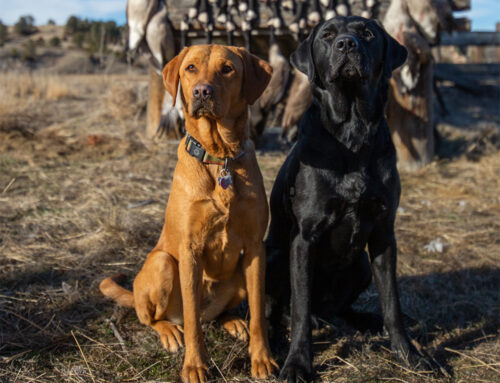
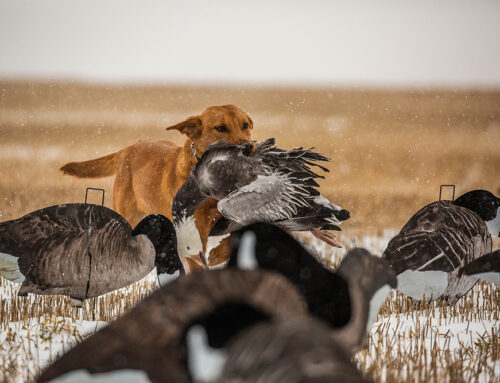
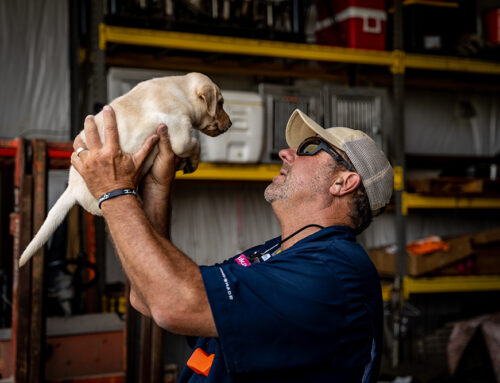
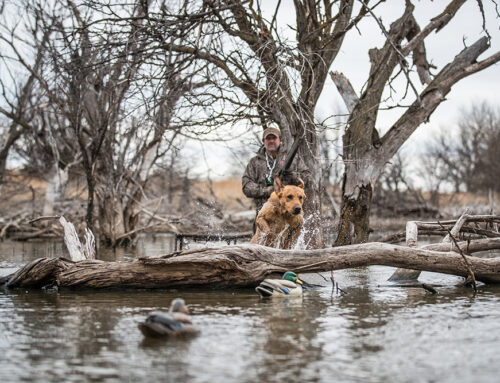
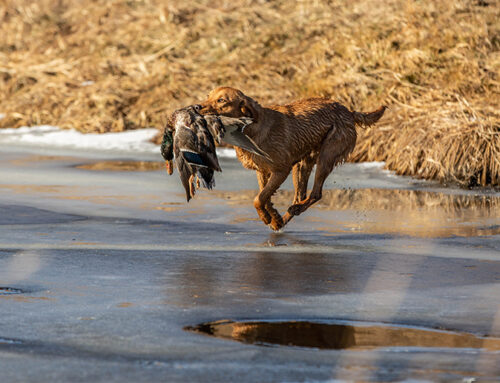
This article erroneously conflates “English” labs with “British” labs.
American Labs: American field trial lines, bred to be athletic, birdy, and work in the field.
British Labs: British field trial lines, bred to be athletic, birdy, and work in the field. (Milner’s dogs at Duckhill)
English Labs: American show lines, bred to be docile and good looking, thick-boned and often overweight, bred primarily to be low-key family pets, not to hunt or compete in field trials.
British and American labs are both athletic, long-legged, bird-obsessed dogs. English labs are not, they are bred for appearance and the AKC ring.
100% correct Spencer! I noticed the same thing.
How dare is the yellow eyed labs